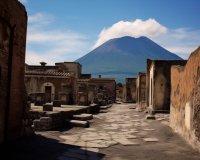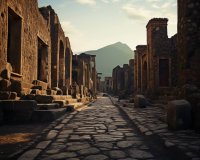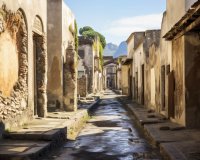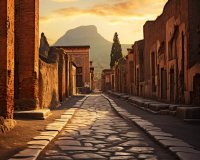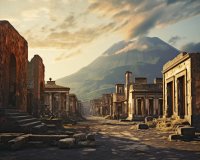Insider’s Guide to the Ancient Ruins of Herculaneum and Pompeii
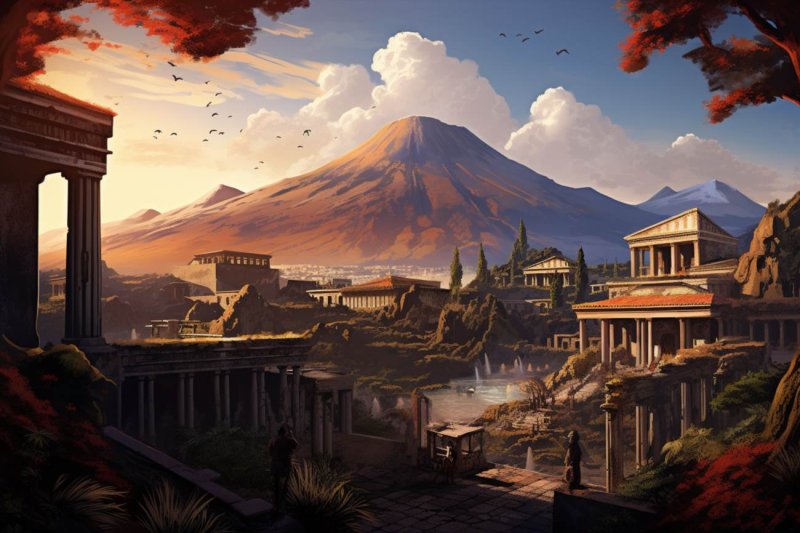
Insider’s Guide to the Ancient Ruins of Herculaneum and Pompeii
Welcome to an insider’s guide to the fascinating ancient ruins of Herculaneum and Pompeii. These archaeological marvels provide a glimpse into the daily lives of people in the ancient Roman world, frozen in time by the catastrophic eruption of Mount Vesuvius in 79 AD.
Both Herculaneum and Pompeii were prosperous Roman cities, but their fates diverged during the eruption. Pompeii was buried under a thick layer of ash and pumice, preserving the city's structures and artifacts. Herculaneum, on the other hand, was covered by a pyroclastic flow, resulting in a remarkable state of preservation.
Herculaneum: Preserved in Ash
Herculaneum was a seaside town, located to the west of Mount Vesuvius. The eruption entombed the city in a thick layer of volcanic ash, which served to protect and preserve the structures and artifacts. Today, visitors to Herculaneum can explore well-preserved buildings, intricate mosaics, frescoes, and even organic materials like wooden furniture.
The site is remarkably compact compared to Pompeii, making it easier to navigate and appreciate the details of daily life. Highlights include the House of the Mosaic Atrium, the Villa of the Papyri, and the House of Neptune and Amphitrite.
Pompeii: A City Frozen in Time
Pompeii, once a bustling city near modern-day Naples, met a tragic fate during the eruption of Mount Vesuvius. The volcanic ash and debris covered the city, preserving it remarkably well for centuries. Today, visitors can walk through the ancient streets, visit homes, markets, temples, and even a well-preserved amphitheater.
Must-see attractions in Pompeii include the Forum, the Villa of the Mysteries, the Temple of Apollo, and the brothel with its explicit frescoes that offer a glimpse into the social norms of the time.
Visiting Tips
Here are some tips to make the most of your visit to these ancient ruins:
- Wear comfortable shoes as you'll be doing a lot of walking and exploring.
- Bring sunscreen, a hat, and plenty of water, especially during the warmer months.
- Consider hiring a guide to provide historical and cultural context, enhancing your experience.
- Respect the site by not touching or climbing on the ancient structures and artifacts.
Conclusion
Exploring the ancient ruins of Herculaneum and Pompeii is a journey back in time, offering invaluable insights into the lives and architecture of ancient Romans. These remarkably preserved sites provide a unique window into history, making them must-visit destinations for history enthusiasts and curious travelers alike.
Naples: Day Trip to Pompeii and Capri
Embark on a fascinating 8-hour journey exploring the ancient ruins of Pompeii and the enchanting island of Capri. Discover the rich history of a city buried by volcanic ash as you wander through the remnants of the Roman Empire with an expert archaeologist guide. Then, experience the allure of the Tyrrhenian Sea as you take a hydrofoil to the glamorous island of Capri from Naples.
Overview
Explore the tragic story of Pompeii, a city frozen in time due to a volcanic eruption, and contrast it with the beauty of Capri, a jewel of the Tyrrhenian Sea. Witness the significant buildings of Pompeii, including theaters, the Forum, Stabian Baths, House of the Faun, and House of the Tragic Poet, gaining insight into life during the Roman Republic.
Details
Start your day trip with a convenient pickup from major hotels in Naples city center, the Cruise Terminal, or Napoli Centrale train station. Drive to Pompeii and enjoy skip-the-line entrance, guided by an archaeologist. Delve into the history of the Roman Empire, exploring theaters, houses, and thermal baths that paint a vivid picture of ancient life.
Return to Naples and board a hydrofoil for a scenic 45-minute sea crossing to Capri. Ascend through lemon groves on a funicular to reach the Piazzetta. Enjoy leisure time to shop, savor authentic Italian coffee at Gran Caffè Vuotto, and explore the narrow streets dotted with boutique fashion stores and local crafts.
Marvel at panoramic views from the Gardens of Augustus, taking in sights like Via Krupp, Mount Solaro, the Bay of Marina Piccola, and the iconic Faraglioni sea stacks. After your Capri exploration, board the hydrofoil back to Naples. Cruise passengers can easily return to their ships, while hotel guests will be transferred by minivan to their accommodations.
Highlights
- Step back in time at Pompeii, uncovering the wonders of the Roman Empire
- Ride the funicular through lemon groves to Capri's charming Piazzetta
- Admire panoramic views of the Tyrrhenian Sea from the Gardens of Augustus
- Indulge in an authentic Italian coffee experience at Gran Caffè Vuotto
- Explore Capri's narrow streets, boutique stores, and local craft shops
Reviews
Rated 4.4 out of 5 based on 163 reviews, this day trip is praised for its insightful guides, seamless logistics, and the perfect blend of historical exploration and scenic beauty.
Activity Provider
Organized by WORLDTOURS S.r.l., this day trip ensures a memorable experience with expert guides and comfortable transportation, allowing travelers to immerse themselves in the captivating histories of Pompeii and Capri.
Unearthing the Secrets of Herculaneum and Pompeii
The ancient cities of Herculaneum and Pompeii, nestled in the shadow of Mount Vesuvius, have long captivated the world with their extraordinary tales of life and tragedy. The eruption of Mount Vesuvius in 79 AD buried these two Roman cities under a thick blanket of volcanic ash, preserving them for centuries and providing a remarkable window into the past.
The story of Herculaneum and Pompeii is one of both destruction and preservation. When the catastrophic eruption occurred, it unleashed a torrent of ash and superheated gases that swiftly consumed the towns and their inhabitants. For centuries, these cities lay hidden beneath layers of volcanic debris.
It wasn't until the 18th century that the world would begin to unearth the secrets of Herculaneum and Pompeii. Excavations led by archaeologists, including Roque Joaquín de Alcubierre and Giuseppe Fiorelli, brought the ancient cities back to life, revealing an astonishingly well-preserved snapshot of daily Roman life.
One of the most remarkable aspects of the excavation was the preservation of architectural features, including homes, temples, and even a brothel. These structures provide insights into Roman architecture and urban planning, offering a glimpse into the lives of the people who called these cities home.
Life and Culture
The preserved buildings of Herculaneum and Pompeii also offer us a unique understanding of daily life in ancient Rome. From the elegant villas with their intricate mosaics to the modest apartments of common citizens, these sites give us a sense of social stratification and the stark differences in living conditions.
One of the most famous findings in Pompeii is the Villa of the Mysteries, a lavishly decorated house that offers a glimpse into the mysterious religious rites of the time. The frescoes that adorn its walls depict scenes of initiation and celebration, sparking endless discussions among scholars about their significance.
In Herculaneum, the ancient library, known as the Villa of the Papyri, revealed an invaluable collection of papyrus scrolls. This discovery shed light on various aspects of Roman intellectual life, including philosophy, poetry, and science. The preservation of these scrolls allowed us to rediscover lost works of ancient authors.
Tragic End and Remarkable Preservation
The tragic fate of the inhabitants of Herculaneum and Pompeii is a poignant chapter in their story. The eruption of Mount Vesuvius happened so suddenly that many residents had little time to escape. Archaeological findings tell us of the desperate attempts made by the people to flee, as well as the victims who perished while seeking refuge in buildings or even boats.
Remarkably, the volcanic ash that buried the cities served as a natural preservative. The layer of ash effectively sealed the sites, protecting them from decay and looting for centuries. As a result, the skeletons of the victims, voids left by decomposed bodies, and even organic materials like wooden furniture and food were preserved in incredible detail.
Modern Discoveries and Ongoing Research
Unearthing the secrets of Herculaneum and Pompeii is an ongoing endeavor. Archaeologists and researchers continue to explore these ancient cities, employing advanced technologies such as ground-penetrating radar and 3D scanning to delve deeper into their mysteries.
Furthermore, the study of ancient DNA has opened up new avenues of research. By analyzing the genetic material of individuals who lived in Herculaneum and Pompeii, scientists can gain insights into the population's ancestry, health, and relatedness. This genetic information provides a more holistic understanding of the people who once thrived in these cities.
Today, Herculaneum and Pompeii are UNESCO World Heritage Sites, drawing visitors from around the world. They stand as living museums of Roman life and the catastrophic event that forever altered their destinies.
As we continue to unearth the secrets of Herculaneum and Pompeii, these ancient cities serve as a testament to the enduring power of preservation and the unending quest to understand our shared human history.
Explore Ancient Pompeii with Skip-the-Line Tickets
Step into the past with a guided walking tour of Pompeii, an ancient Roman city frozen in time by the eruption of Vesuvius in 79 AD. Benefit from skip-the-line tickets for swift access to this archaeological marvel.
Listen as your expert guide unfolds the history and architecture of Pompeii, revealing the daily lives of its inhabitants. Wander through well-preserved streets, visiting key sites like the Basilica, Forum, thermal baths, and Theater. Discover the remnants of commercial and residential neighborhoods, including a bakery and housing blocks.
This 4-hour experience includes a 2-hour guided tour in a small group setting, ensuring an intimate exploration of Pompeii's wonders. Your journey begins with convenient pick-up and drop-off in Naples, enhancing your travel comfort. Dive deep into the rich history of this UNESCO World Heritage site.
Don't miss the chance to witness the impressive restoration of Villa Vettii, adding a unique touch to your Pompeii adventure. Marvel at frescoes that were unveiled just six months ago, complementing the allure of the entire complex.
Book your spot today for a captivating journey through the echoes of ancient Rome!
The Life and Catastrophe of Pompeii
Pompeii, a once-thriving Roman city, holds a unique place in history due to its life and catastrophic destruction in 79 AD. Nestled in the shadow of Mount Vesuvius, Pompeii enjoyed a rich and prosperous existence before it was buried under layers of volcanic ash and pumice.
Life in Pompeii:
Pompeii was a bustling city in the Roman Empire, with a population estimated at around 20,000 people. It was known for its thriving economy, beautiful architecture, and a bustling marketplace. The city was filled with impressive buildings, temples, theaters, and luxurious villas.
The Catastrophe:
In August 79 AD, the tranquility of Pompeii was shattered when Mount Vesuvius erupted. The eruption was so cataclysmic that it buried the entire city under meters of volcanic debris. This catastrophic event left Pompeii frozen in time, preserving it for centuries to come.
As the volcano spewed ash, pumice, and molten rock, Pompeii's residents were caught off guard. Many tried to flee, but the city was quickly enveloped in a thick cloud of ash and deadly gases. Thousands of people were buried alive, their lives forever frozen in a moment of desperation and fear.
Rediscovery and Preservation:
Pompeii remained lost for centuries until its accidental rediscovery in the 18th century. Excavations began, revealing a remarkably well-preserved snapshot of Roman life. The ruins of Pompeii have provided invaluable insights into ancient Roman culture, art, and architecture.
Notable Finds:
The excavations at Pompeii have unearthed a wealth of treasures, including intricate frescoes, mosaics, sculptures, and everyday objects. Notable discoveries include the Garden of the Fugitives, which showcases plaster casts of victims, and the House of the Vettii, a beautifully preserved Roman villa.
| Notable Finds |
Description |
| Garden of the Fugitives |
Plaster casts of the victims, capturing their final moments. |
| House of the Vettii |
A well-preserved Roman villa with stunning frescoes and architecture. |
Legacy:
Pompeii's tragic story has left a lasting impact on our understanding of history and natural disasters. The city serves as a poignant reminder of the fragility of human existence and the unpredictable power of nature. It has also become a UNESCO World Heritage Site, drawing millions of visitors each year who come to witness the preserved remains of this ancient Roman city.
In conclusion, the life and catastrophe of Pompeii is a compelling tale of a prosperous city abruptly halted by the devastating eruption of Mount Vesuvius. Through excavation and preservation, we have gained an invaluable glimpse into the daily lives and culture of ancient Romans, forever etching Pompeii into the annals of history.


